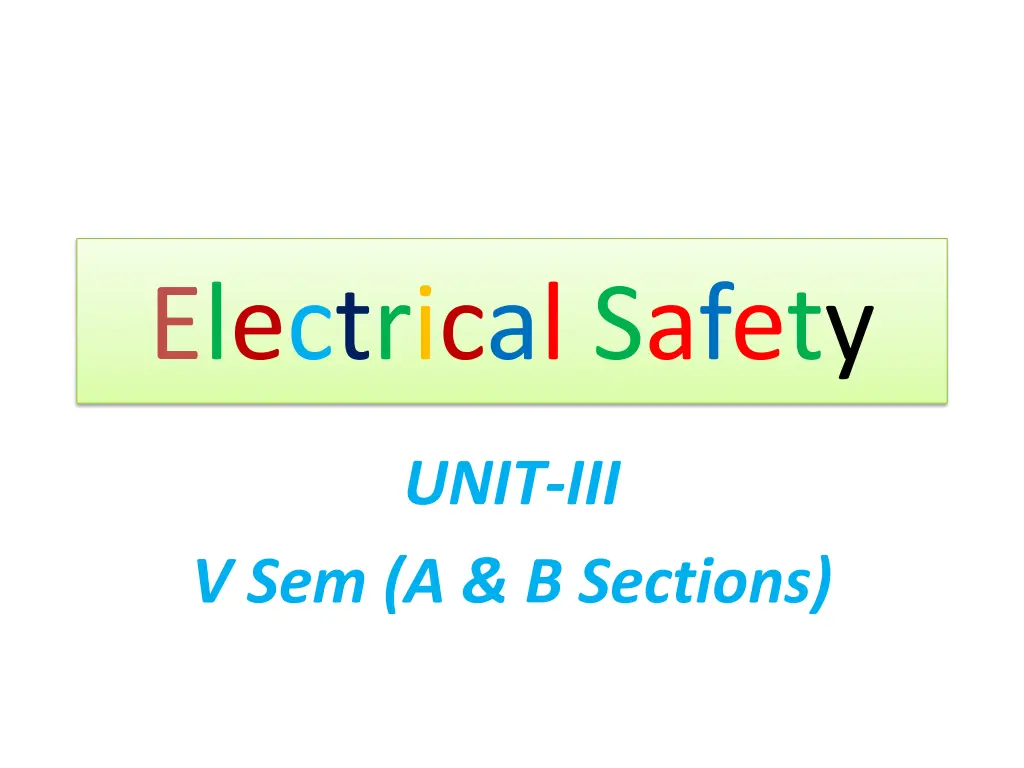
Safety Procedures and Methods in Electrical Systems
Explore safety procedures including pre-job briefings, hot work decision tree, safe switching, lockout/tagout, arc protection calculations, and more for low and high voltage systems. Understand the importance of effective grounding and the severity of induced voltages in de-energized conductors to ensure electrical safety.
Download Presentation

Please find below an Image/Link to download the presentation.
The content on the website is provided AS IS for your information and personal use only. It may not be sold, licensed, or shared on other websites without obtaining consent from the author. If you encounter any issues during the download, it is possible that the publisher has removed the file from their server.
You are allowed to download the files provided on this website for personal or commercial use, subject to the condition that they are used lawfully. All files are the property of their respective owners.
The content on the website is provided AS IS for your information and personal use only. It may not be sold, licensed, or shared on other websites without obtaining consent from the author.
E N D
Presentation Transcript
Electrical Safety UNIT-III V Sem (A & B Sections)
UNIT-III: Safety Procedures and Methods The six Steps safety methods pre job briefings hot work decision tree safe switching of power system lock out tag out calculation and approach distances calculating the required level of arc protection safety procedure for low voltage and high voltage systems - safety audit. flash hazard equipment, the one minute
Review-unit-I &II Electrical safety of personnel (customers/worker/animals) Electrical Equipment safety Power system equipment like power transformers, generators, transmission lines, distribution transformers, distribution feeders House hold appliances Effective grounding system
Problems & Overcome Faults single phase to ground, three-phase faults Overload, over current, overvoltage, under frequency of machines Coordinated Protective devices-fuses, circuit breakers, relays Effective grounding Power system Restoration Power system maintenance
De-energized conductor A conductor that is disconnected from all energy sources by breakers or switches feeding the line A conductor that is disconnected from any energy source and voltage due to electromagnetic coupling A conductor that is disconnected from both of its ends and intentionally grounded at the line sides of the circuit breakers A conductor that is disconnected from both of its ends and grounded at the worksite opening all circuit free from induced
The severity of the induced voltage depends Voltage and current of the energized line Proximity of the two lines Length by which the two lines run adjacent to each other Fault-current on adjacent lines Besides induced voltage, the de-energized lines could become energized due to other events such as Lightning strikes Switching equipment malfunction Human error
The six Steps safety methods Think be aware. Understand your procedures. Follow your procedures. Use appropriate safety equipment. Ask if you are unsure, and do not assume. Do not answer if you do not know.
ThinkBe Aware Many accidents could have been prevented if the injured victim had concentrated on the safety aspects of the job. Thinking about personal problems while working energized conductors is a one-way ticket to an accident. Always stay alert to the electrical hazards around the work area. or on job-related or near
Understand Your Procedures Every company has defined safety procedures that are to be followed. Workers should be thoroughly familiar with all the safety procedures that affect their jobs. Knowledge of the required steps and the reasons for those steps can save a life. All employees should go through extensive safety training.
Follow Your Procedures In the past, some facilities have allowed the violation of safety procedures in the name of production. Such actions are in violation of the law and have invariably proven to be costly in terms of human injury and/or death. Violation of safety procedures without good cause should be a discharge offense. What constitutes good decided on a local basis; however, excuses of lesser significance than immediate danger to life should not be acceptable. cause must be
Use Appropriate Safety Equipment No accidents do occasionally happen. Equipment failures, lightning strikes, switching surges, and other such events can cause shock, arc, or blast. Also, sometimes it becomes employees to work energized conductors, which increases the chance of accidental contact. Because of these reasons, appropriate safety equipment should be used any time workers are exposed to the possibility of electrical hazards. matter how meticulous workers are, necessary very for to on or close
Ask If You Are Unsure, and Do Not Assume Ignorance kills and injures many people each year. No one should ever get fired for asking a question especially if it is a safety-related question. Anyone who is uncertain about a particular situation should be questions, which should then be answered by a qualified person immediately and to the fullest extent possible. encouraged to ask
JOB BRIEFINGS A job briefing (sometimes called a tailgate meeting ) is a meeting that informs all workers of the job requirements. In particular, a job briefing is used to alert workers to potential safety hazards. A job briefing need gathering; however, it is mandatory that all workers involved attendance should be documented. not be a formal attend, and worker
Illustrative Example Assume that a 20 km de-energized line is accidentally energized by a 2 kV source while a lineman is working at the far end of the line. The line resistance is 0.1 /km, and the worker s body resistance plus his ground resistance is 1000 . 1. Compute the current passing through the lineman and the voltage across his body. 2. Assume a 0.001 temporary grounding conductor is installed between the line and the ground in parallel with the worker. Compute the current passing through the lineman and the voltage across his body.
Discuss Issues When? Special precautions to be taken Hazards associated with the job Energy control procedures Procedures and policies Personal protective equipment At the beginning of each shift At the beginning of any new job Any time that job conditions change When new personnel are introduced to an ongoing job
ENERGIZED OR DE-ENERGIZED? All regulatory standards are quite clear in their requirements, that All circuits and components to which employees may be exposed should be de- energized before work begins. A few basic points will clarify this requirement: Production or loss of production is never an acceptable, sole reason to work on or near an energized circuit. If work can be rescheduled to be done de-energized, it should be rescheduled. De-energized troubleshooting is always preferred over energized troubleshooting. The qualified employee doing the work must always make the final decision as to whether the circuit is to be de-energized.
Start Will this work expose the worker to the energized part of over 50 volts? Work is De-energized proceed Circuits of less than 50 volts to ground may generally be considered as de-energized. If the circuit has high arcing potential, answer #1 as YES NO YES Will the additional Hazard be introduced by de- energizing? Can the work be to a later time when it can be performed de- energized? YES NO YES Would the De- energization require a major shutdown? STOP Schedule the work for later. NO NO YES Can the work be performed safely using safety-related work procedures? YES Does the nature of work require energization? NO Proceed with caution NO STOP The circuits MUST be de- energized for this work.
Examples of Additional Hazards Interruption of life-support systems Deactivation of emergency alarms Shutdown of ventilation to hazardous locations Removal of illumination from the work area
Examples of Collateral Costs That May Justify Energized Work Excessive restart times in continuous process systems High product loss costs (in polyethylene process, for example, the product has to be physically dug out of process equipment after an unscheduled outage) Testing electrical circuits (to verify de - energization, for example) Troubleshooting complex controls Infrared scan
Steps Required before De-energized Work May Commence 1. All energy control devices feeding the work area must be opened. 2. Locks and tags shall be placed on the energy control devices. 3. Voltage measurements shall be made at the point(s) of exposure to verify that the circuit is De-energized. 4. Safety grounds (if required) shall be placed to ensure the existence of an equipotential work zone. 5. The work area must be closely inspected by a qualified person to make certain that no energized parts remain. This critical step is often missed.
SAFE SWITCHING OF POWER SYSTEMS De-energizing/clearing/Turning-off Switching should be done by qualified personnel. Non-load interrupting devices are not intended to interrupt any current flow. Circuit breaks should never be closed after they interrupt a fault until the cause of the fault has been determined and corrected.
Remote Operation There are at least three different ways that electrical switchgear such as circuit breakers and switches can be operated safely. Operating from a remote control room Operating using a remote operating device Operating manually from the device panel
Electrical Safety Analysis Substation Electrical Load-1 Power from Genera ting station Protective Fuse/C.B Switch Substation Electrical Load-2
Clearing procedures The clearing procedures for even so simple a case, should include checking to ensure that no other sources exist and that the correct isolating device is being operated. It is important that all persons who may be exposed to a hazard, as a result of a switching action, be notified prior to the action. It is necessary to use written switching instructions for systems that may have several sources into an area.
Typical padlocks suitable for lockout purposes.
Multiple-lock devices. Locking devices
Typical application of locks, tags, and multiple-lock devices
Tag out & Lockout Tags are used to identify equipment that has been removed from service for maintenance or other purposes. They are uniquely designed and have clear warnings printed on them instructing personnel not to operate the equipment. Do Not Start, Do Not Open, Do Not Close, Do Not Operate Locks are applied to de-energized equipment to prevent accidental or unauthorized operation. Locks and tags are normally applied together.
When to Use Locks and Tags Locks and tags should be applied to open circuit breakers, switches, or contactors whenever personnel will be exposed to the conductors that are normally fed by those devices. The application of the tags will warn and inform other employees that the equipment is not available for service, who applied the tag, and why the tag was applied. The lock will prevent the operation of the breaker, switch, or contactor so that the circuit cannot be accidentally re-energized. Minor inspections, adjustments, measurements, and other such servicing activities that are routine, repetitive, and integral to the use of the equipment do not require the placement of locks and tags.
Tags without Locks Used under both of the following conditions: The interrupting designed to accept a lock. An extra means of isolation is employed to provide one additional level of protection. Such an extra procedure might take the form of an additional open point such as removing a fuse or disconnecting a wire or the placement of safety grounds to provide an equipotential work area. device (C.B) is not
Locks without Tags Used under both of the following conditions: The de-energization is limited to only one circuit or piece of equipment. The lockout lasts only as long as the employee who places the lock is on-site and in the immediate area.
Rules for Using Locks and Tags All electric equipment with the capability to be reenergized and harm employees shall be safely isolated by means of a lock and tag during maintenance, repair, or modification of the equipment.
FLASH HAZARD CALCULATIONS AND APPROACH DISTANCES How close to an electrical hazard can I get? Approach Distance Definitions shock hazard distance and flash hazard distance 1.The employee must be qualified to cross the boundary. 2.The employee must be wearing appropriate personal protective equipment. 3.Proper planning must be carried out to prepare the employee for the hazards he/she may face.
Calculating the Flash Hazard Minimum Approach Distance (Flash Protection Boundary)
The Required Level of ARC Protection Flash protection beyond normal cotton or wool work clothing is not required as long as all parts of the worker s body stay outside the flash boundary as calculated above. Outside the flash boundary, the minimum recommendation is either: 1. Flame-resistant clothing with an ATPV of 4.5 cal/cm2 or higher 2. Natural fabric (cotton or wool) work clothing of 7 oz/yd2 or more
Electrical arc test setup used to determine Arc Thermal Performance Value Once Incident energies can be calculated, then protective clothing can be purchased with the necessary ratings.
Calculating Incident Energy Levels- Method-1 This method is based on a research by Richard L. Doughty, Thomas E . Neal, and H. Landis Floyd. Their research was bounded by the following conditions: Systems with voltage levels of 600 V and below Systems with maximum available short-circuit currents between 16 kA and 50 kA Working distances of equal to or greater than 18 in After running numerous tests by creating electric arcs in open air, they took their results and performed a curve fit to predict the incident energy
Curve fit to predict the incident energy EMA = 5271DA-1.9593 tA(0.0016I2SC -0.0076ISC+0.8938) where EMA = maximum open-air arc incident energy (cal/cm2) DA = distance from the electrodes (in) note that DA 18 in tA = duration of the arc (seconds) ISC = short-circuit current (kA) note that ISC is the actual arc current, not the maximum bolted fault current In the second part of their research, they created electrical arcs in a cubic box with one open side. The box was 20 in on a side and the measurements were taken at various distances from the open end. EMA = 1038.7DB-1.4738 tA(0.0093I2SC -0.3453ISC+5.9675) where EMB = maximum arc-in-a-box incident energy (cal/cm2) DB = distance from the electrodes (in) note that DB 18 in
Estimation / curve fit Y = [M]X X = [M]-1Y Y-MX =error when M rectangular = i N + 2 min ( ( )) y ax b i i 1 Min(error)2
Arc-Flash Calculations 1. Arc flash current: The current of the arc, which is often less than the bolted fault current. 2. Incident energy: It is a measure of the thermal energy at a distance from an arc fault. 3. Flash boundary: A minimum distance from the energized object where the person cannot encroach.
Calculating Arc flash current(IEEE Standard 1584 -2002.) One of the principal drawbacks of the Lee method is that the bolted fault current, which is used in that method, is always somewhat greater than the actual current flow when an electrical arc is formed. log10(Ia) = K + 0.662 log10(Ibf) + 0.0966V + 0.000526G + 0.5588V log10(Ibf) 0.00304G log10(Ibf) (<1000 Volts) log10(Ia) = 0.00402 + 0.983 log10(Ibf)) (>1000 Volts) Where Ia = arcing current (kA) K = a constant ( 0.153 for open configurations or 0.097 for box configurations) Ibf = the bolted, RMS symmetrical, three-phase fault current (kA) V = system phase-to-phase voltage (kV) G = the gap between the arcing conductors (mm)
Calculating Incident Energy The calculation of actual incident energy is done in two steps using the empirically derived arc current (Ia). In step one, normalized incident energy (En) is calculated. En is normalized for an arcing time of 0.2 second and a distance from the arc of 610 mm. log10En= k1+ k2+ 1.081(log10Ia) + 0.0011G where En = normalized incident energy (cal/cm2) k1= 0.792 for open-air arcs and 0.555 for arcs-in-a-box k2 = 0 for ungrounded and high-resistance ground systems and 0.113 for grounded systems G = conductor gap (arc length) (mm)
Flash-Hazard calculations - Problems 1. A 480 V motor control center (MCC) has a bolted fault current of 10 kA. Compute the arc current. 2. Consider 16 kV open air buses with bolted fault current of 10 kA, the gap between buses being 150 mm. Compute the arc flash current. For a 480 V switch gear enclosure, compute the arc fault current if the bolted fault current is 5 kA.




















